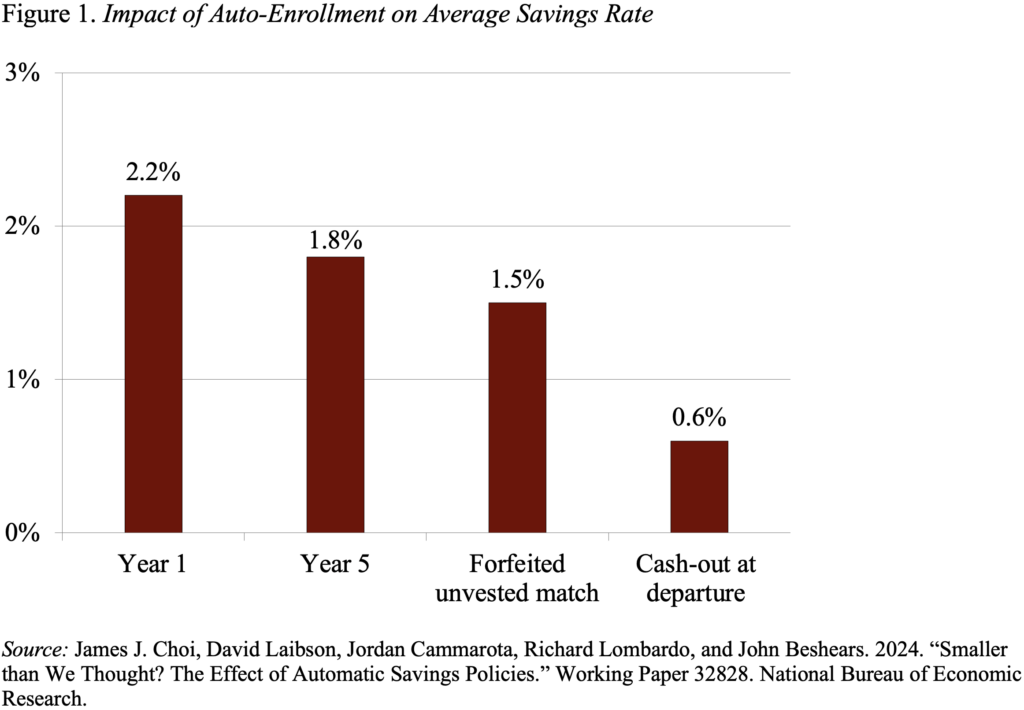An extended look lowers estimates of its influence, however making saving straightforward stays important.
The identical analysis workforce that documented the influence of auto-enrollment and auto-escalation in 401(ok) plans has returned to the subject to evaluate how real-life occasions have an effect on the longer-run impact of those computerized provisions. I feel it’s actually cool for researchers to return and kick the tires on earlier outcomes. My studying is that the authors nonetheless suppose these computerized provisions are useful – and so they do little hurt – however the magnitude of the optimistic impact on financial savings is way smaller than they’d initially thought.
Some background. As 401(ok)s began to interchange conventional outlined profit plans within the Nineties, critics famous the burden positioned on would-be contributors. They needed to determine whether or not or to not be a part of the plan, how a lot to contribute, methods to make investments these contributions, methods to change asset allocations and their contribution charge as they aged, methods to deal with accumulations after they modified jobs, and the way to attract down investments in retirement. That’s lots. In response, educational and business people tried to determine how altering plan design might make the method simpler and thereby enhance participation charges and balances.
The key innovation capitalized on inertia. It concerned shifting the enrollment mechanism from opt-in, the place workers needed to proactively signal as much as take part, to opt-out, the place workers had been routinely enrolled within the plan at a specific contribution charge. In a 2001 research, one member of the “gang” confirmed that when a big U.S. company launched auto-enrollment the share contributing to the plan elevated from 37 % to 86 %. This impact was a lot greater than that from employer matching contributions. Furthermore, later work discovered that it didn’t depend upon the default contribution charge, be it 3 % or 6 %. Noticeably, individuals have a tendency to stay with the default charge.
Numerous this early work contributed to provisions within the Pension Safety Act of 2006, which inspired computerized enrollment and auto-escalation within the default contribution charge. (The laws additionally sanctioned goal date funds.) And SECURE 2.0 requires most new 401(ok) pans to implement each auto-enrollment and auto-escalation.
Whereas the impact of the auto provisions on participation is evident and sturdy, the impact on contributions is somewhat trickier. Auto-enrollment will enhance the contribution charge of those that would by no means have joined the plan and those that would have joined at a decrease charge, however will lower contributions of those that would have contributed greater than the default. On common, the research confirmed that auto-enrollment elevated contributions. This discovering raises the query of the place the extra contributions come from. Did contributors cut back their spending or tackle extra debt? Whereas a research of recent civilian hires within the federal Thrift Financial savings Plan confirmed little to no damaging credit score results, an evaluation of obligatory auto-enrollment in the UK, with a a lot bigger pattern measurement, discovered that the optimistic impact of auto-enrollment on retirement plan saving was partially – about 20 % – offset by a rise in unsecured debt.
All that is background to the gang’s most up-to-date paper, which appears at different elements – past elevated debt – which may undermine the optimistic impact of auto-enrollment. For his or her pattern, the first-year expertise means that auto-enrollment elevated the financial savings charge by 2.2 share factors (see Determine 1). (For simplicity, this dialogue focuses on auto-enrollment, however incorporating auto-escalation produces an identical sample.) After 5 years of employment, nonetheless, this share drops to 1.8 share factors, as a result of many people not topic to auto-enrollment actively enhance their contribution charges, which erodes a number of the financial savings hole. As well as, worker turnover is excessive, and lots of go away earlier than their employer matching contributions are absolutely vested, which additional reduces the increment within the saving charge to 1.5 share factors. Lastly, as a result of these routinely enrolled have comparatively small balances, their cash-out charge at departure is greater than those that decide in, which additional reduces the increment within the saving charge to 0.6 share factors.

So the place does that go away us? Auto-enrollment considerably will increase participation and has a optimistic internet impact on saving. And whereas solely the first-year influence overstates the long-term increment to saving, specializing in the real-world problems overstates the damaging influence on worker well-being. Certainly, just a few thousand {dollars} could also be welcome help for an worker transitioning from one job to a different. So even when not good, making saving computerized and straightforward ought to proceed to be our purpose.

